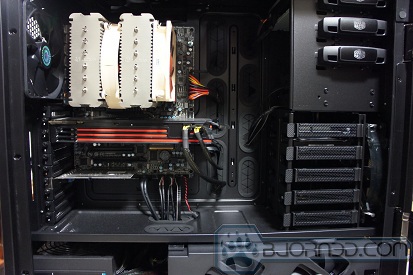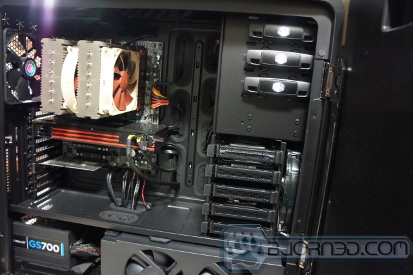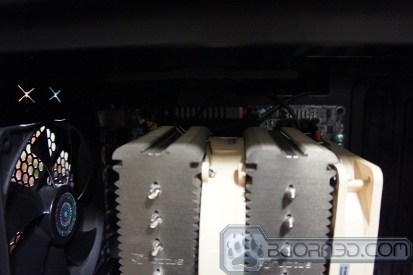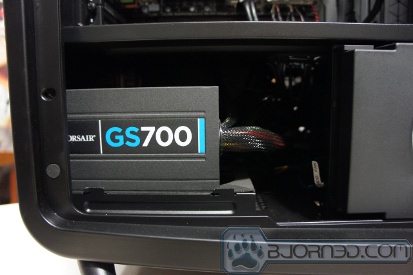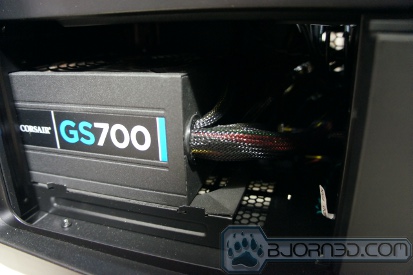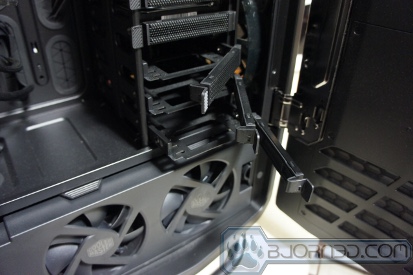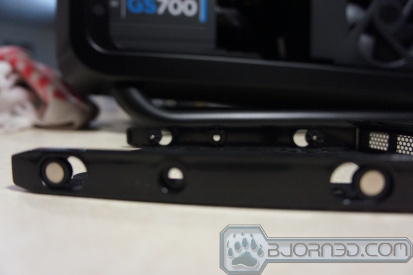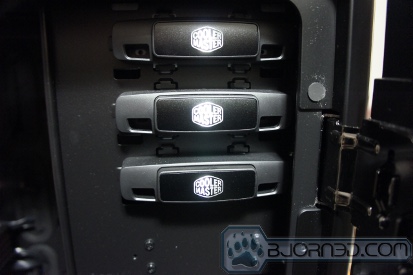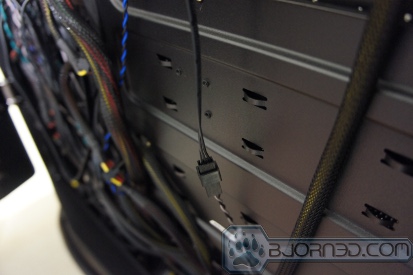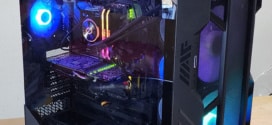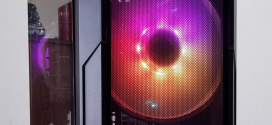The first Ultra Tower case has finally hit the market. Check out the COSMOS II to see what this beast has inside.
Introduction

“Must just be marketing” was the first thing we thought when we looked over the specifications of this case. Even after looking at pre-release pictures online and looking at specifications it didn’t really sink in that this was an “Ultra Tower”.
The case is indeed on a whole new level that requires some sort of moniker beyond ‘full tower’. This monster can fit any size motherboard, any size graphics card, and any cooling setup we could dream up.
It can fit a whopping thirteen hard drives or solid state drives.
The question of whether or not the case is almost laughably large isn’t the point of this review, but we thought it worth mentioning that this is a gigantic case.
Continue reading to find out our impressions of the design of the case, it’s build quality, ease of use, and effect on overall system cooling.
There has yet been no price announced for the COSMOS II.
Features
- Rich I/O support (USB 3.0 x2 , USB 2.0 x 4, e-SATA); Intelligent LED fan speed control panel on the top
- Supports high-end hardware such as XL-ATX motherboards, 4-Way SLI or Crossfire (10+1 expansion slots)
- Room for future upgrades with support for up to 13 HDD or SSD
- Dust filters on every intake are removable to allow easy cleaning
- Support for a mix of 360mm or 240mm radiator(s)
- Easy transport with handles
- Easy cable management and routing
- Individual airflow chambers for system components; improving thermal management
- Supports large 140mm case exhaust fan
- Aluminum sliding front door protects 5.25” bay drives and devices
- Majority of the construction is aluminum with steel and mesh used for style and strength
Specifications
|
|
Cooler Master COSMOS II |
|
Available Color |
Black |
|
Dimensions |
344(W) x 704(H) x 664(D) mm 13.5(W) x 27.7(H) x 26.1(D) inch |
|
Net Weight |
21.5kb / 47.3lb |
|
Motherboard Type |
Micro-ATX, ATX, E-ATX, XL-ATX, SSI CEB, SSI EEB |
|
Case Material |
Appearance: Aluminum, Mesh Plastic Case Body: Steel |
|
5.25″ Drive Bay |
3 |
|
3.5″ Drive Bay |
13 (2 from X-Docking, Mid.cage for 5 HDDs, Bottom cage for 6 HDDs) |
| 2.5″/3.5″ Drive Bay | 11 (converted from 3.5″ bay) |
| Expansion Slot | 10 + 1 |
| Maximum Compatibility |
CPU cooler height: 190 mm / 7.48 in. GPU card length: 385 mm / 15.10 in. |
| I/O Panel | USB 3.0 x 2 (internal), USB 2.0 x 4, e-SATA x 1, Audio In and Out ( Supports HD audio) |
| Cooling System |
Front: 200mm LED fan x 1 (converted from 120/140mm x 1) Top: 120mm black fan x 1 (converted from 200mm fan x 1/ 140 mm fan x 2 / 120 mm fan x 3) Rear: 140mm fan x 1 Side: 120mm fan x 2 (optional) HDD: 120mm fan x 3 (2 fans for bottom HDD / 1 fan for Mid. HDDs) |
The Exterior of the CM COSMOS II
Click Images For An Expanded View
Click Images For An Expanded View
Click Images For An Expanded View
The front of the case is composed of a great deal of metal and plastic mesh surround by hard black plastic to again allow for better airflow throughout this monster. The 5.25″ drive bays at the top of the case, of which there are three, are covered by a plastic piece that easily clips in and out of position allowing for easy removal and replacement of drives. Below those are the two hot-swappable and lockable hard drive bays that Cooler Master calls “X-Dock” bays that can accommodate standard 3.5″ drives. If the sliding door on the front of the case is in its upright and locked position the bottom of the case is simply black metal mesh with a fan behind them which glows with a blue LED light. This causes the case to have a very striking appearance when closed.
Click Images For An Expanded View
The back end of the case is a rather standard affair with the basic layout of I/O panel opening and expansion slots although it does have an included rear fan and three pre-cut holes for tubing. Far more remarkable than the back of the case is the front panel, which features a very full-featured connection layout including two USB 3.0 ports, four USB 2.0 ports, an eSATA port, and the standard 3.5mm microphone and headphone jacks.
Click Images For An Expanded View
Finally, just above the connection panel is what Cooler Master calls its “Advanced Control Panel” which can be easily hidden by another sliding aluminum/plastic door. This panel is basically an included and wonderfully designed fan controller which features excellent buttons with background LEDs to indicate fan speed, power status, and hard drive activity. While it may have been a real pain to get organized and set up, the included fan controller is certainly a nice touch and one of our favorite features of the COSMOS II.
The interior of the CM COSMOS II
Click Images For An Expanded View
We were very happy with the interior of the case. First of all, the doors are intelligently placed on gloss black hinges which enable us to finally be rid of thumb screws, Philips head screwdrivers, or aligning annoying metal cutouts to close our cases. We can now close our case like we close our car door, and it even has a similar latch on either side of the case to open the door back up.
Once the door is opened, the above images are what we see. The interior of the case is made almost entirely of a steel alloy that has been painted black. The big bundle in the middle consists primarily of cables relating to the fan controller and also the standard case headers. The box contains a bunch of goodies that can be seen in an image down below.
In these images we can see the three tool less 5.25″ bays on the top right of the case which can accommodate drives with the simple push of a button. The empty space beneath them is, again, the 2 X-Dock bays, and below that is space for five 3.5″ or 2.5″ hard drives which can all be held in place via a plastic bendable tool-less cradle.
The motherboard tray has a generous cutout to allow for easy access to the CPU cooler, and several cut-outs within easy reach of the motherboard which are sheathed in rubber to allow for a very presentable overall look should users put in the time and effort to manage your cables.
Click Images For An Expanded View
As can be seen above there are two fans housed in a hard black plastic shell that hide six more 3.5″ or 2.5″ hard drive bays that use the same tool less design present in the rest of the case. The fans can be swung out as shown to allow easy access to the drives or to remove the hard drive cages altogether.
Beside the dual-fan housing is the power supply bay which elevates the power supply on a thin layer of material, allowing for sound dampening and better air flow.
That is another favorable aspect of this case: every fan and opening on the case comes with a dust-filter attached to the opening to allow for easy dust management and removal again with air cooling in mind.
The last thing to mention before moving on to hardware installation is the box of supplies that comes with the case. Included are a number of fable ties, two metal mounting brackets for radiators, an ATX 6-pin to 8-pin converter, case screws, and the keys to your newest desk-bending toy.
Description of Hardware installation
The installation of the system was a breeze to say the least. With the tremendous amount of room inside the case there should really never be any problem when it comes to being able to fit even four GPU’s or multiple radiators/reservoir.
To begin with Cooler Master has made installing the motherboard jumpers quite easy due to the labels placed next to each and every of the many holes on the motherboard tray along with a small key on the bottom left to illustrate which holes to use depending on the form factor of the motherboard.
The PSU installation for this case uses a removable frame. Users must first remove the cradle from the rear of the case by removing four thumbscrews. Then, users can secure their power supply outside of the case to the cradle via the four traditional screws. The PSU and cradle will then slide in to the case and be re-secured with the thumbscrews but by pushing out the PSU bracket a bit it allows space for power supplies that are a little longer than normal.
As described on the previous page, hard drive and optical drive installation is as simple as could be. For hard drives, users can simply snap the bracket out of the track and bend it around the drive. There are small inserts that fit inside the screw holes on the hard drive to secure it to the bracket, and then the user can simply place it back in the track and clip it in to place. After 10 seconds, we have an installed and fully secured hard drive.
Optical drive installation is even easier. On the front of the case there are hard plastic covers on the 5.25″ bays which can be unclipped via pulling on the small handle. Once the opening is available, users can simply slide the drive in and press the button to lock it.
The Cooler Master COSMOS II also has the best cable management setup we’ve ever used with its ample cutouts in the motherboard tray that are lined with rubber to provide a clean look and the tremendous amount of space behind the tray for routing cables. The end result is a very sharp looking system for users who are willing to take the time to actually route cables intelligent and tie them down in the back to the many metal anchors placed around the case.
The only complaint we have about the case is the sheer number of cables required for the case connectors and the fan controller. There is a huge mess of wires on the other side of the nice, neat motherboard tray due to the many, many connector cables for fan control, fan LED control, and other case connectors. While the added feature of the fan controller certainly outweighs the annoyance of the cabling, it is worth noting nonetheless.
TESTING METHODOLOGY
Our CPU and GPU temperatures were ascertained by stressing the system not with some program made specifically for that purpose but rather playing Battlefield 3 on the highest settings possible. The game was used for load conditions, and temperatures were recorded at their peak with CoreTemp and MSI Afterburner. Motherboard temperatures were recorded at the same time with AIDA64 monitoring tool.
| Test Rig | |
| Case | Cooler Master COSMOS II |
| CPU |
Intel Core i7 2700k 3.5Ghz @ 4.7Ghz |
| Motherboard | GIGABYTE GA-Z68X-UD7-B |
| Ram |
8Gb G.Skill Ripjaw DDR3-1600 Model F3-12800CL9S-4GBRL |
| CPU Cooler | Noctua NH-D14 |
| Hard Drives |
Western Digital Caviar Black 1TB Model WD1002FAEX |
| SSD |
Intel 320 Series 160GB |
| Optical | LG Blu-Ray ROM |
| GPU |
Powercolor Radeon 6950 2GB (Reference flashed to 6970) |
| PSU |
Corsair GS700 |
| Mouse | Logitech G700 |
| Keyboard | Razer Blackwidow Ultimate |
RESULTS
Here are the temperatures we got from our testing:
| Temperature (ambient @ 17 C) | ||||
|---|---|---|---|---|
| Idle (Low Fan) | Idle (High Fan) | Load (Low Fan) | Load (Max Fan) | |
| CPU | 40C | 38C | 82C | 78C |
| GPU | 40C | 33C | 81C | 76C |
| Motherboard | 26C | 26C | 27C | 27C |
It is somewhat difficult to give an accurate representation of the effect of a case on overall system temperatures. It would seem logical that if users were to shove in a few more GPU’s, hard drives, or other devices, the internal temperature of the case would rise dramatically, and the thought Cooler Master has put in to the design and airflow of the case would actually come in handy.
Compared to the old Cooler Master HAF 920, the COSMOS II is much quieter, and though the system is audible, the case fans themselves don’t contribute to the noise levels. Again, this test is subjective and should be relevant to all those who don’t desire absolutely silent PC’s. In a more objective test, we are confident that the results would be in line with my observations but in this scenario we unfortunately had no means to measure objective decibel levels.
CONCLUSION
Using the Cooler Master COSMOS II has been one of the best experiences we’ve had with a case. The COSMOS II is by far the most well laid out case we’ve ever seen, and has been the easiest to work on and deal with. It’s gargantuan space on the inside, ample methods for cable routing, hinged doors, tool less bays, and so much more make the case an absolute dream for the builder who is constantly tinkering and changing his system.
Its excellent ventilation and large amount of internal space will ensure that there will be no shortage of airflow within the case for even the most high-performing components. In addition, enthusiasts will have plenty of room to tinker with their hardware inside the case. The case’s great cable management is also sure to come in handy for enthusiasts who put in the time and effort. There is no price yet announced for the COSMOS II case, but we assume it will be around USD $349.99.
There are a few negative points, the first being that it is a very large, very heavy case. This case is not recommended for users who want portable systems. Though it is easy to move around thanks to its handles, the fact remains that the case alone weighs almost 50 lbs. In addition, the hinged doors sometimes swing out and cause problems.
Overall, however, we enjoyed working with this case a great deal, and it has definitely earned our recommendation.
| Our Verdict: Cooler Master COSMOS II | ||||||||||||||||||||
|
||||||||||||||||||||
| Summary: The first ultra tower case to hit the market has given us a taste of what it truly means to have it all. With abundant connectivity, included fan controller, and great interior layout, the Cooler Master COSMOS II earns the Bjorn3D Golden Bear Award. |
 Bjorn3D.com Bjorn3d.com – Satisfying Your Daily Tech Cravings Since 1996
Bjorn3D.com Bjorn3d.com – Satisfying Your Daily Tech Cravings Since 1996






















